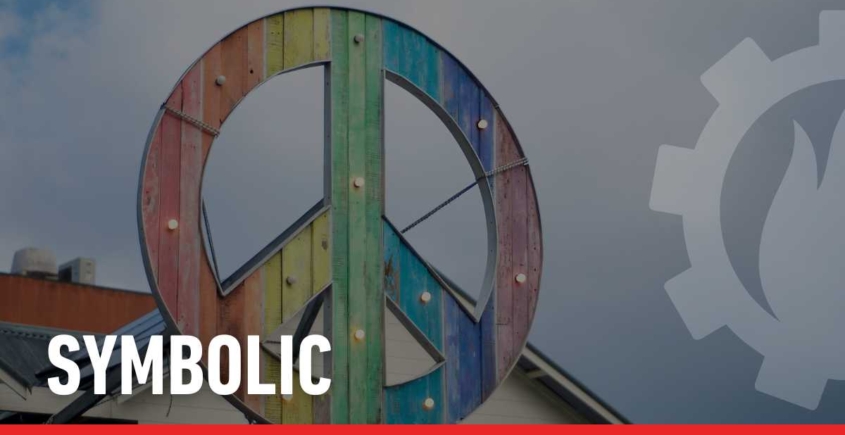Symbolic
Symbols. They are all around us. Without really thinking, we respond to six sided STOP signs, traffic lights, hazardous chemical marks, UL branding, the recycling arrow symbol, text alerts, street crossing ways, handicap signs, and of course the yellow smile face (thanks Forest Gump). I’m sure you can think of many more. One symbol, that still resonates with people around the world is the simple “peace” sign. Its initial design set out to represent a statement regarding nuclear disarmament but has grown to envelope so many movements with a simple message: PEACE. I did a bit of searching and found some interesting info to share about its construction and other peace signs, some of which you may not know about. Thanks to Wikipedia and Google and YouTube for the info. Enjoy – and as always, Peace to you and your families from your friends at KHT!

I did not know this!. :))))))))))))))))))
The original circle peace sign was designed in 1958 by Gerald Holtom, a British graphic designer and artist. It was created for the Campaign for Nuclear Disarmament (CND) in the United Kingdom, which was organizing a protest march against nuclear weapons from London to the Atomic Weapons Research Establishment at Aldermaston.
Holtom, a conscientious objector during World War II, sought a symbol that would resonate with the anti-nuclear movement. He combined the semaphore (learn more HERE) signals for the letters “N” and “D” (standing for Nuclear Disarmament). In semaphore, the letter “N” is represented by a person holding two flags in an inverted “V” shape, and “D” is represented by one flag pointed straight up and the other pointed straight down. When these two signals are superimposed, they form the central design of the peace sign.
The circle around the semaphore design represents the world, encompassing the desire for global peace and disarmament. Holtom also explained that the symbol was intended to depict a person in despair with arms outstretched downward, reflecting his personal feelings of hopelessness about the state of the world at the time.
The symbol was first used during the CND’s march in 1958 and quickly became the official logo of the organization. It gained prominence in the UK as a symbol of the anti-nuclear movement.
During the 1960s, the peace sign was adopted by various groups in the United States, particularly by the civil rights and anti-Vietnam War movements. It’s clear and simple design made it a powerful emblem for peace and non-violence.
Despite its anti-establishment roots, the peace sign has been widely commercialized and used in fashion, merchandise, and popular culture. It is a testament to its enduring appeal and recognition.
The use of the olive branch as a symbol of peace in Western civilization dates at least to 5th century BC Greece. The olive branch, which the Greeks believed represented plenty and drove away evil spirits, was one of the attributes of Eirene, the Greek goddess of peace. Eirene (whom the Romans called Pax), appeared on Roman Imperial coins with an olive branch. A branch in the claws of an eagle can be found in American currency.
Poets of the 17th century associated the olive branch with peace. A Charles I gold coin of 1644 shows the monarch with sword and olive branch. Throughout the 18th century, English coins show Britannia with a spear and olive branch.
A dove and olive branch are also prevalent in Christian history, dating back to the early days of wall paintings from the early Christian Catacombs of Marcellinus and Peter in Rome, showing Noah, in the orante attitude of prayer, the dove and an olive branch. The descent of Holy Spirit in the Christian Trinity is depicted as a dove of peace in church imagery and stained glass windows.
Nicholas Roerich (1874–1947), a Russian artist, cultural activist, and philosopher, founded a movement to protect cultural artifacts. Its symbol was a maroon-on-white emblem consisting of three solid circles in a surrounding circle. It has also been used as a peace banner. In 1935 a pact initiated by Roerich was signed by the United States and Latin American nations, agreeing that “historic monuments, museums, scientific, artistic, educational and cultural institutions” should be protected both in times of peace and war.
The peace sign remains a potent symbol used in protests and movements advocating for peace, environmental protection, and human rights around the world. It has been featured in countless artworks, songs, and media, further embedding it in global consciousness.
It’s a powerful example of how a simple graphic can convey a profound message and become an enduring symbol for universal ideals.
::::::::::::::::::::::::::::::::::::::::::::::::::::::::::::::::::::::::::::::::::::::::::
DO YOU LIKE CONTESTS?
Me, too.
As you may know the Kowalski Heat Treating logo finds its way
into the visuals of my Friday posts.
I. Love. My. Logo.
One week there could be three logos.
The next week there could be 15 logos.
And sometimes the logo is very small or just a partial logo showing.
But there are always logos in some of the pictures.
So, I challenge you, my beloved readers, to count them and send me a
quick email with the total number of logos in the Friday post.
On the following Tuesday I’ll pick a winner from the correct answers
and send that lucky person some great KHT swag.
So, start counting and good luck!
Oh, and the logos at the very top header don’t count.
Got it? Good. :-))))
Have fun!!
::::::::::::::::::::::::::::::::::::::::::::::::::::::::::::::::::::::::::::::::::::::::::






Leave a Reply
Want to join the discussion?Feel free to contribute!